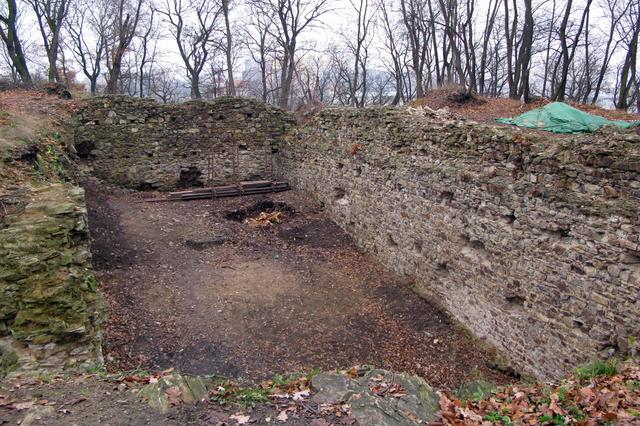
The new castle in Kunratice is freely accessible - Horydoly.cz - Outdoor Generation
Nový hrad (also Nový hrádek, Hrádek or Wenzelsburg) in Kunratice has a short and fast history.
Roman Emperor and Czech King Wenceslas IV. (1361-1419) was secured with money, titles and power by his father Charles IV. However, Europe was already unstable, the papal schism was destroying the unity of the faith, the Reformation was on the way, pestilences spread across the continent, the coming Little Ice Age caused famines. The wars were not long in coming.
Václav IV. at this time he lost the title of Roman Emperor, maneuvered between the support of Hussites and Catholics, was arrested by the Bohemian nobility, became weaker and weaker. In the end, he started drinking and perhaps only loved his game of prey kept in today's Municipal House and today's Stromovce, and also hunted in the Czech forests.
Where was the Přemyslovsk hunting forest
The Legendary Velká Kunratická runs through Hrádek
1407 Czech king Wenceslas IV. is based on a water fortress in Záběhlice, an ancient village far outside Prague, today a Prague district. He buys the nearby indebted estate of the Olbramovickés, which stretches along a wooded ridge above the bogs of Botič and Kunratické brooks from today's Hostivařský dam to Krč. He likes hunting and the forests he bought are ideal hunting terrain.
1411 Wenceslas IV. no longer feels safe in his fortress and plans the New Castle above the Kunratický údolí. The inaccessible promontory protects the steep rocky slopes on three sides. There is convenient access from the east along the narrow isthmus, which the king has a deep moat cross and builds a drawbridge over.
1412 King Wenceslas IV. is moving to a new seat. The fortifications of the New Castle are being improved by a water reservoir on the Kunratické stream deep in the valley.
1419 The new castle is completed and fully functional in the style of the last defensive tactics of the Gothic castle builders. The floor plan has the shape of an irregular pentagon, measuring seventy meters in length. Against the drawbridge, the fortification faces a sharply broken wing with two and a half meter thick masonry. The reason for this is increased resistance to artillery fire. There is a tower, a palace, cellars and even a library.
16. August 1419, Wenceslas IV. stricken with a heart attack and falls dead to the ground. His successor is his brother Zikmund of Luxemburg.5. November 1419, the queen - widow Žofia takes refuge in the New Castle.May 1420 Zikmund visits Žofia in New Castle and she leaves with him at the end of May. The king keeps a military garrison here.

After 1800, slate was quarried under the castle and the ruins were partially destroyed by a quarry.
1881 The five meter high walls are torn down for safety. Only the walls on the ground or underground remain. Remains of the Hussite camp were also preserved.
In 1923, archeological surveys began, which lasted until 2013 with major breaks.
28. September 2013 The new castle is open to the public. Cleared medieval foundations can be seen and a drawbridge leads to them. Access is free and you can get here on foot, by bike, e-bike or wheelchair.INFO: Interactive photo gallery of the Kunratic Forest
The photos were taken as part of a large Agogs e-bike test, which appeared in BIKE magazine 2013/3 and will be published simultaneously in OUTDOOR magazine 2013/2.
Transportation
A blue tourist sign leads to Nový hrad u Kunratic along comfortable and wide forest paths. The nearest metro stations are Chodov and Roztyly. The nearest city bus stop is Zelené domky. The cycle path leads under the castle around the Kunratické stream from Kunratic via Vídeňská street to Krča Braník. A side branch branches off from it to the Václavka spring, from where it is not far to Nový hrad.
You can find stylish excursion restaurants right in the Kunratický les U krále Václav IV. (including a mini ZOO) and On the green meadow.
Horydoly castles and chateaux
Andělská horaBardo (Poland) Bělá pod BezdězemBerštejnBezdězBormio (Italy) Budyšín/Bautzen (Germany) Carcassonne (France) Čachtice (Slovakia) and Čachtická paní (Slovakia) DěvínDobříšEhrenberg Reutte (Austria) )Eilean Donan (Scotland)FalkenburkFalkenstein (Austria)Firmian - Sigmundskron (Italy)HazmburkHerštejn StarýHořoviceChillon (Switzerland)ChyšeChoustníkJezeříKácovKadaňKamenice nad LipouKlenováKostelec nad Černý lesyKostomlatyKostelní BřízaKlenováKostelnica nad Černý lesyKošťálovKrakowecKrivoklatKunetická Mountain Chimneys RefrigeratorLeontyn Castle LišnoLužanyMoritzburg (Germany)Soap Factory / KostomlatyNeuschwanstein and Hohenschwangau (Germany)Nottingham (England)New Castle KunraticeNymburkPeckaPísekPrague CastlePřimdaRábíRalskoReutte (Austria) Skokloster (Sweden)Staatz (Austria)SychrovSionTetínTower (England)Trenčín (Slovakia)Vadstena (Sweden)Valdek 1 and Valdek 2ZásadkaZbiroh 1 and Zbiroh 2Zborov (Slovakia)Žebrák
Monasteries and churches
Altenburg: baroque cosmos of the Benedictines (Austria) Hrušková: St. Nicholas under Krudum Chlum svaté Máří: Assumption of the Virgin Mary Hradiště Monastery Levý Hradec: St. Kliment's churchOberndorf: Stille Nacht (Austria) Pivoň: Augustinian monasteryPlasy : Cistercian MonasteryPrague: Rotunda of St. WenceslasStará Boleslav: Church of St. WenceslasRome: Basilica of St. Peter (Vatican)Tachov: SvětceWaldsassen: Nazi fresco in the chapel near Münchenreuth (Germany)
Show the place Turistika on a larger map







